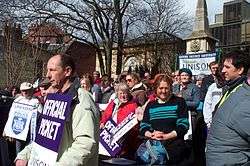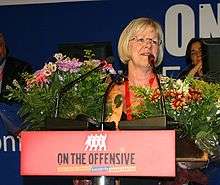Trade unions in the United Kingdom
| National trade union organization(s) TUC, STUC, ICTU | |
| National government agency(ies) Department for Business, Innovation and Skills | |
| Primary trade union legislation Trade Union and Labour Relations (Consolidation) Act 1992 | |
|
| |
| Trade union membership 7.3 million | |
| International Labour Organization The United Kingdom is a member of the ILO | |
| Convention ratification | |
| Freedom of Association | 27 June 1949 |
| Right to Organise | 30 June 1950 |

Trade unions in the United Kingdom were first decriminalised under the recommendation of a Royal Commission in 1867, which agreed that the establishment of the organisations was to the advantage of both employers and employees. Legalised in 1871, the trade union movement sought to reform socio-economic conditions for working men in British industries, and the trade unions' search for this led to the creation of a Labour Representation Committee which effectively formed the basis for today's Labour Party, which still has extensive links with the Trade Union Movement in Britain. Margaret Thatcher's governments weakened the powers of the unions in the 1980s, in particular by making it more difficult to strike legally, and some within the British trades union movement criticised Tony Blair's Labour government for not reversing some of Thatcher's changes. Most British unions are members of the TUC, the Trades Union Congress (founded in 1867), or where appropriate, the Scottish Trades Union Congress or the Irish Congress of Trade Unions, which are the country's principal national trade union centres.
Membership declined steeply in the 1980s and 1990s, falling from 13 million in 1979 to around 7.3 million in 2000. In September 2012 union membership dropped below 6 million for the first time since the 1940s.[1]
History
Law
Much like corporations,[2] trade unions were regarded as criminal until the Combination Act 1825, and were regarded as quasi-legal organisations, subjected to the restraint of trade doctrine, until the Trade Union Act 1871. This Act abolished common law restrictions, but took an abstentionist stance to unions internal affairs. The Trade Disputes Act 1906 exempted trade-union funds from liability in action for damages for torts, and this freedom gave future union pickets a great deal of power.
Democratic organisation
The principle that the common law enforced a union's own rules, and that unions were free to arrange their affairs is reflected in the ILO Freedom of Association Convention, and article 11 of the European Convention on Human Rights, subject to the requirement that regulations "necessary in a democratic society" may be imposed. Unions must have an executive body and that executive must, under TULRCA 1992 sections 46 to 56, be elected at least every five years, directly in a secret, equal postal vote of union members.
Union constitutions
The structure of the unions were based in contract and the rights of members depended on being able to show some proprietary interest to be specifically enforced.[3] This meant that the express terms of the union rule book can, like any contract, be supplemented with implied terms by the courts as strictly necessary to reflect the reasonable expectations of the parties,[4] for instance, by implying the Electoral Reform Service's guidance to say what happens in a tie break situation during an election when the union rules are silent.[5] If there are irregular occurrences in the affairs of the union, for instance if negligence or mismanagement is not alleged and a majority could vote on the issue to forgive them, then members have no individual rights to contest executive decision making.[6] However, if a union's leadership acts ultra vires, beyond its powers set out in the union constitution, if the alleged wrongdoers are in control, if a special supra-majority procedure is flouted, or a member's personal right is broken, the members may bring a derivative claim in court to sue or restrain the executive members. So in Edwards v Halliwell[7] a decision of the executive committee of the National Union of Vehicle Builders to increase membership fees, which were set in the constitution and required a ⅔ majority vote, was able to be restrained by a claim from individual members because this touched both a personal right under the constitution and flouted a special procedure.
Discipline and expulsion
- ASLEF v United Kingdom [2007] ECHR 184
- McVitae v UNISON [1996] IRLR 33
- Roebuck v NUM (Yorkshire Area) No 2 [1978] ICR 676, Templeman J
- Esterman v NALGO [1974] ICR 625, Templeman J
- Radford v NATSOPA [1972] ICR 484, Plowman J
Dispute resolution
- Hamlet v GMBATU [1987] ICR 150, Harman J
- Longley v NUJ [1987] IRLR 109
Union members' rights
- TULRCA 1992 ss 28-31, true and fair view of accounts, member's right to inspect, and complaints to Certification Officer.
- TULRCA 1992 ss 62-65, right to require a ballot before industrial action, and no detriment may follow
- Knowles v Fire Brigades Union [1997] ICR 595
- Edwards v Society of Graphical and Allied Trades [1971] Ch 354
- Cheall v APEX [1983] 2 AC 180
- TULRCA 1992 s 174
- ASLEF v United Kingdom [2007] ECHR 184
- Amalgamated Society of Railway Servants v Osborne [1910] AC 87, political donations
- Trade Union Act 1913
- Birch v National Union of Railwaymen [1950] Ch 602
- TULRCA 1992 s 72-73 and 82
- Paul v NALGO [1987] IRLR 413
- Weaver v NATFHE [1988] ICR 599 EAT
Unions organisation

Margaret Thatcher's Conservative government starting in 1979 saw trade unions as an obstacle to economic growth and passed restrictive legislation of the sort the Tories had long avoided.[8]
Membership declined steeply in the 1980s and 1990s, falling from 13 million in 1979 to around 7.3 million in 2000. In 2012 union membership dropped below 6 million for the first time since the 1940s.[9] From 1980 to 1998, the proportion of employees who were union members fell from 52 per cent to 30 per cent.[10]
Union membership declined in parallel with the reduction in size of many traditional industries which had been highly unionised, such as steel, coal, printing, and the docks.[11]
In 2015, the Conservative government introduced a new Trade Union Bill, which proposes stricter ballot thresholds for industrial action, further restraints on picketing and a requirement that union members ‘opt in’ to political funds.[12]
International affiliations
See also
- Conspiracy and Protection of Property Act 1875
- Criminal Law Amendment Act 1871
- Employers and Workmen Act 1875
- History of trade unions in the United Kingdom
- List of unions in the United Kingdom
- Trade Union Freedom Bill
- Union Modernisation Fund
Notes
- ↑ John Moylan (7 September 2012). "Union membership has halved since 1980". BBC.
- ↑ See the Bubble Act 1725 and the Combination Act 1799
- ↑ See Rigby v Connel (1880) 4 Ch D 482 and Lee v Showmen’s Guild of Great Britain [1952] 2 QB 359
- ↑ See Equitable Life Assurance Society v Hyman [2000] UKHL 39 and AG of Belize v Belize Telecom Ltd [2009] UKPC 10
- ↑ AB v CD [2001] IRLR 808. See also, Breen v Amalgamated Engineering Union [1971] 2 QB 175, where the dissenting judgment of Lord Denning MR is probably an accurate reflection of the law after Hyman and Belize
- ↑ See Foss v Harbottle (1843) 67 ER 189
- ↑ [1950] 2 All ER 1064
- ↑ Neil J. Mitchell, "Where traditional Tories fear to tread: Mrs Thatcher's trade union policy." West European Politics 10#1 (1987): 33-45.
- ↑ John Moylan (7 September 2012). "Union membership has halved since 1980". BBC.
- ↑ Andrew Charlwood, "The anatomy of union membership decline in Great Britain 1980-1998" (PhD . Diss. The London School of Economics and Political Science (LSE), 2013), Bibliography pp 212-22. online.
- ↑ See graph
- ↑ Williamson, Adrian (8 March 2016). "'The Trade Union Bill 2015: echoes of the General Strike?'". History and Policy. Retrieved 28 June 2016.
Further reading
- Aldcroft, D. H. and Oliver, M. J., eds. Trade Unions and the Economy, 1870–2000. (2000).
- Campbell, A., Fishman, N., and McIlroy, J. eds. British Trade Unions and Industrial Politics: The Post-War Compromise 1945–64 (1999).
- Charlesworth, Andrew, Gilbert, David, Randall, Adrian, Southall, Humphrey and Wrigley, Chris. An Atlas of Industrial Protest in Britain, 1750–1990 (1996).
- Clegg, H.A. et al. A History of British Trade Unions Since 1889 (1964); A History of British Trade Unions Since 1889: vol. 2 1911-1933. (1985); A History of British Trade Unionism Since 1889, vol. 3: 1934–51 (1994), The major scholarly history; highly detailed.
- Davies, A. J. To Build a New Jerusalem: Labour Movement from the 1890s to the 1990s (1996).
- Laybourn, Keith. A history of British trade unionism c. 1770-1990 (1992).
- Minkin, Lewis. The Contentious Alliance: Trade Unions and the Labour Party (1991) 708 pp online
- Pelling, Henry. A history of British trade unionism (1987).
- Wrigley, Chris, ed. British Trade Unions, 1945-1995 (Manchester University Press, 1997)
- Wrigley, Chris. British Trade Unions since 1933 (2002) 115 pp online
- Zeitlin, Jonathan. "From labour history to the history of industrial relations." Economic History Review 40.2 (1987): 159-184. Historiography